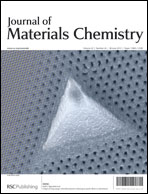Silicon is a promising anode material for lithium ion batteries because of its low discharge potential and high theoretical charge capacity (4200 mA h g−1). However, the poor cycle performance, which arises from the large volume change upon the insertion and extraction of lithium ions, has limited its application. Here, we introduce a composite structure of coaxial carbon–silicon–carbon nanotube arrays in a porous anodic aluminium oxide membrane as a high-capacity and long-life anode. The carbon layer can not only protect silicon from generating a solid electrolyte interphase, but can also function as the current collector. These anode materials have a high first Coulombic efficiency of 90% and high specific capacities (∼4000 mA h g−1 for silicon and more than 600 mA h g−1 for the whole anode). Significantly, using these composite structures we have obtained an area capacity of ∼6 mA h cm−2, which is larger than commercial graphite anode values.
You have access to this article
 Please wait while we load your content...
Something went wrong. Try again?
Please wait while we load your content...
Something went wrong. Try again?


 Please wait while we load your content...
Please wait while we load your content...